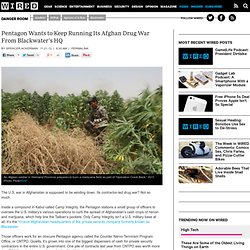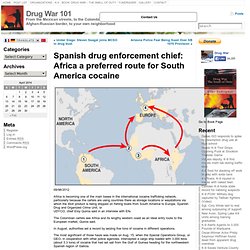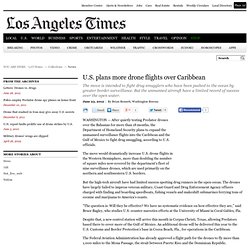

Pentagon Wants to Keep Running Its Afghan Drug War From Blackwater's HQ. An Afghan soldier in Helmand Province prepares to burn a marijuana field as part of “Operation Crack Back,” 2011.

Photo: Flickr/ISAF. Mexican Cartels Enslave Engineers to Build Radio Network. The Mexican military is trying to dismantle an extensive network of radio antennas built and operated by the notorious Zeta drug cartel.

But the authorities haven’t had much luck shutting Radio Zeta down. Not only is much of the equipment super-easy to replace. But the cartel has also apparently found some unwilling — and alarming — assistance by kidnapping and enslaving technicians to help build it. At least 36 engineers and technicians have been kidnapped in the past four years, according to a report from Mexican news site Animal Politico, with an English translation published by organized-crime monitoring group InSight.
Worse, none of the engineers have been held for ransom — they’ve just disappeared. “None of the systems engineers who disappeared have been found,” Gonzalez said. For at least six years, Mexico’s cartels have relied in part on a sophisticated radio network to handle their communications.
Hezbollah in South America. We have to find new solutions to Latin America's drugs nightmare. Twenty years ago, I became head of intelligence services in the Guatemalan army.

In this capacity, I had to co-ordinate operations with several United States and Latin American agencies dealing with the fight against drug trafficking. In those years, this was already a challenging and complex task. However, Guatemala's security forces had the capacity to deal with the problem, intercepting drug convoys and arresting drug lords. Probably the most important victory on this front was our sophisticated and discreet intelligence operation that led to the arrest of a prominent Mexican drug lord, who was subsequently sent to Mexico for trial. None the less, the drug lord stayed in jail only eight years, managing to escape from a high-security prison, something that in itself shows the corrupting tentacles of drug trafficking. Three months ago, I became president of Guatemala. And facts are what we need to concentrate on when considering drug policy options. Guatemala becomes killing field as drug wars spread through Central America.
It is called a war, but there is no frontline or thunder of battle in this scorched wilderness.

There is only a no man's land where the dead pile up in silence and the living have nothing to say. Twenty-seven farm labourers were decapitated and had their heads strewn across a field one recent night, but ask neighbours and they reply with blank looks and apologetic shrugs, as if it happened in a distant land. Two well-known peasant leaders were killed in separate incidents as if by phantoms. Broad daylight, but no witnesses. Months later, some in the community profess ignorance it even happened. Yes, they are dead.
Welcome to El Naranjo, a sun-blistered one-street town on Guatemala's northern frontier, once in the middle of nowhere, now in the middle of Latin America's drug war. The isthmus has been a transit point for Andean cocaine for decades, but its importance to cartels has multiplied since the US coastguard shut down alternative Caribbean routes. Spanish drug enforcement chief: Africa a preferred route for South America cocaine. Africa is becoming one of the main bases in the international cocaine trafficking network, particularly because the cartels are using countries there as storage locations or waystations via which the illicit product is being shipped on fishing boats from South America to Europe, Spanish Drug and Organized Crime Unit, or UDYCO, chief Eloy Quiros said in an interview with Efe.

The Colombian cartels see Africa and its lengthy western coast as an ideal entry route to the European market, Quiros said. In August, authorities set a record by seizing five tons of cocaine in different operations. The most significant of those hauls was made on Aug. 15, when the Special Operations Group, or GEO, in cooperation with other police agencies, intercepted a cargo ship loaded with 3,000 kilos (about 3.3 tons) of cocaine that had set sail from the Gulf of Guinea heading for the northwestern Spanish region of Galicia.
World-cannabis-laws.png (1357×628) Image002.jpg (1217×1013) Drone flights set to expand over Caribbean to fight drug traffic. WASHINGTON — After quietly testing Predator drones over the Bahamas for more than 18 months, the Department of Homeland Security plans to expand the unmanned surveillance flights into the Caribbean and the Gulf of Mexico to fight drug smuggling, according to U.S. officials.

The move would dramatically increase U.S. drone flights in the Western Hemisphere, more than doubling the number of square miles now covered by the department's fleet of nine surveillance drones, which are used primarily on the northern and southwestern U.S. borders. But the high-tech aircraft have had limited success spotting drug runners in the open ocean.
The drones have largely failed to impress veteran military, Coast Guard and Drug Enforcement Agency officers charged with finding and boarding speedboats, fishing vessels and makeshift submarines ferrying tons of cocaine and marijuana to America's coasts.